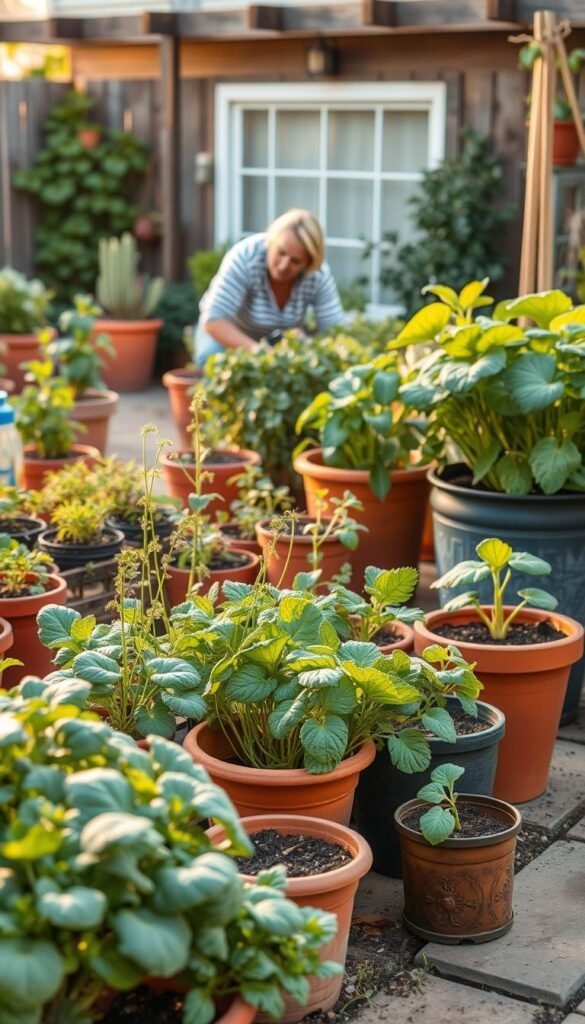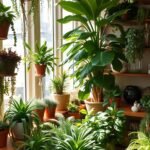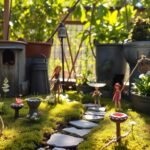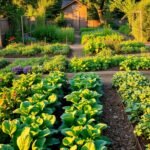Ever wonder why your tomato plants struggle while your herbs thrive? It often comes down to pot dimensions. Picking the perfect home for your veggies isn’t just about looks—it’s about giving roots room to breathe and access nutrients.
Small containers dry out faster, leaving plants thirsty. Oversized pots waste soil and make watering tricky. The sweet spot? Match your plant’s needs. Leafy greens like spinach do well in 6-inch-deep pots, while tomatoes demand 18-24 inches for strong roots.
Here’s a pro tip: When unsure, always size up. A roomier container helps prevent overcrowding and gives plants space to flourish. Our vegetable container chart simplifies decisions—whether you’re growing peppers in fabric pots or carrots in window boxes.
You’ll discover how to balance soil volume with drainage needs, choose materials that last, and avoid common mistakes. Let’s turn your patio into a productive oasis—one perfectly sized pot at a time!
Understanding the Importance of Container Size in Gardening

Did you know your plant’s roots act like a hidden engine? Their growth directly determines whether your greens flourish or falter. Container size shapes this invisible world beneath the soil, affecting everything from hydration to nutrient access.
How Pot Size Influences Plant Health
Small pots create a thirsty environment. Soil dries faster, forcing you to water constantly. Oversized containers hold excess moisture, risking root rot. The key is balance—your plants need enough space to drink steadily without drowning.
Take tomatoes as an example. They thrive in 5-gallon containers but suffocate in salad-green pots. A cramped home leads to root-bound conditions, where roots circle tightly and stunt growth. This stress makes plants vulnerable to pests and diseases.
The Relationship Between Container Size and Root Development
Roots need room to spread like underground branches. In shallow containers, they hit walls and twist. Deeper pots let them grow downward, accessing more nutrients. For vining veggies like beans, vertical space matters as much as width.
Struggling to decide? Follow the “size up” rule. A slightly larger pot gives roots breathing room and simplifies watering. Check our vegetable container chart for quick comparisons—it shows minimum vs. ideal depths for popular crops.
Remember: Healthy roots mean happy harvests. Give them space to work their magic, and your garden will reward you with vibrant growth.
Container Gardening Essentials for Beginners

New to growing your own food? Container gardening turns balconies, patios, and windowsills into mini-farms. Unlike traditional plots, you control every detail—from soil mix to sunlight exposure—without breaking your back.
Why Containers Make Gardening Accessible
Start with a single pot and watch your confidence grow. Herbs like basil thrive in 8-inch containers, while cherry tomatoes need 5-gallon buckets. This flexibility lets you match plant needs to your available space.
Controlled environments mean fewer weeds and pests. Move pots away from harsh weather or hungry critters. Beginners love how containers simplify watering—no guessing about moisture levels in vast garden beds.
Use charts to pick perfect homes for your favorites. Look for depth recommendations: carrots need 12-inch pots, lettuce grows in 6-inch trays. Start with easy vegetables like radishes or spinach before tackling vining crops.
Experiment freely! Try different pot materials and soil blends. A failed pepper plant teaches more than a textbook chapter. Remember: Every seasoned gardener began with one container and a packet of seeds.
Key Factors When Selecting a Container
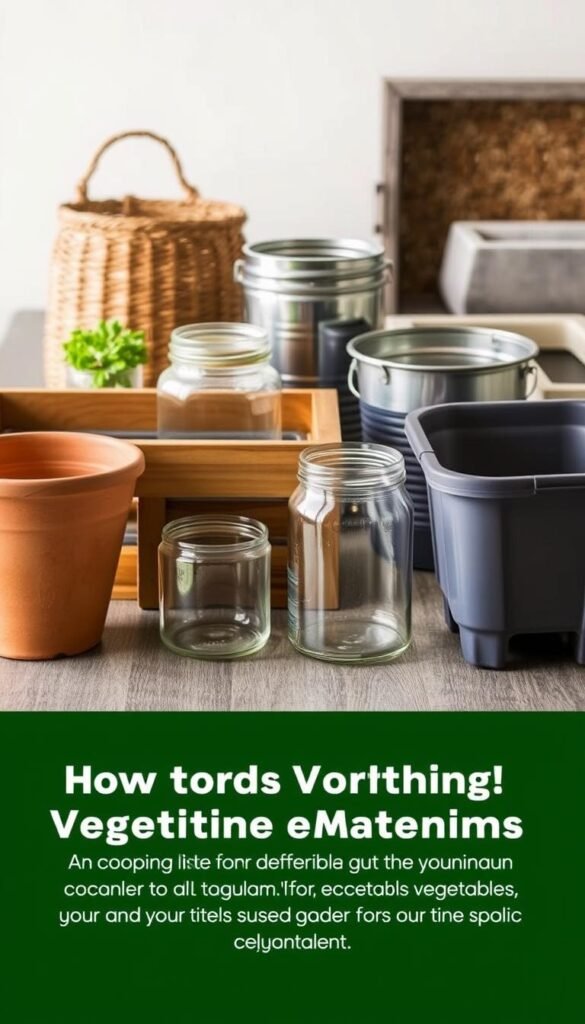
What separates thriving container gardens from struggling ones? Three elements make all the difference: your soil composition, watering habits, and the physical properties of your pots. Let’s break down these make-or-break factors.
Soil, Water, and Space Considerations
Premium potting mix acts like a five-star hotel for roots. It holds moisture without drowning plants, unlike dense garden soil. For tomatoes and other thirsty crops, add perlite to boost drainage.
Container depth directly impacts watering frequency. Shallow pots dry out faster—ideal for herbs but risky for zucchini. Always check mature plant dimensions before planting. A pepper’s 18-inch spread needs breathing room!
Material and Weight: Finding What Works Best for You
Terracotta breathes well but cracks in frost. Plastic stays lightweight yet fades over time. Concrete offers durability but becomes backbreaking when moved. Match materials to your garden’s conditions and your strength.
Hot climates? Glazed ceramic slows evaporation. Limited space? Foldable fabric containers save room when not in use. Remember: Your plants need stability more than aesthetics—wobbly pots tip over in wind.
Pro tip: Use wheeled bases for heavy containers. They’ll let you chase sunlight through the season without straining your back.
Vegetable Container Size Chart: Your Gardening Blueprint

Think of your container garden as a real estate market—every plant wants prime space. Our vegetable container chart acts like a property guide, showing which crops need studio apartments versus sprawling estates.
Interpreting Minimum vs. Preferred Sizes
Minimum pot sizes keep plants alive. Preferred sizes let them thrive. Basil survives in 6-inch containers but produces triple the leaves in 10-inch pots. Pole beans? They’ll climb in 8-inch depth but fruit heavily in 12-inch.
| Vegetable | Minimum Pot Size | Preferred Pot Size |
|---|---|---|
| Tomato | 5 gallons | 10 gallons |
| Bush Beans | 8″ depth | 12″ depth |
| Basil | 6″ diameter | 10″ diameter |
Tips for Managing Plant Spacing and Crowding
Follow the “one plant per container” rule for large vegetables like tomatoes. For smaller crops like lettuce, space 6-8 inches apart. Overcrowding steals nutrients and invites mold.
Rotate pots weekly if growing against walls. This prevents lopsided growth. In humid climates, add 2 extra inches between plants—better airflow means fewer fungal issues.
Remember: Charts show averages. Adjust based on your garden’s sunlight and soil mix. A windy balcony? Go one size up to anchor roots against gusts.
Avoiding Common Container Gardening Pitfalls

Struggling with wilting plants despite daily care? Many gardeners face challenges like dried-out soil or stunted growth without knowing the root cause. Two major issues plague container gardens: cramped roots and inconsistent moisture. Let’s explore how to sidestep these frustrations and keep your greens thriving.
Smart Solutions for Healthy Roots and Hydration
Root-bound plants occur when roots spiral tightly in undersized pots. This limits nutrient absorption and slows growth. Tomatoes, for example, drop blossoms when stressed. Always check if roots peek through drainage holes—a clear sign to repot.
Small containers dry out fast, especially in summer heat. A 6-inch pot might need watering twice daily. Upgrade to deeper pots for moisture retention. Pair this with mulch (like coconut coir) to reduce evaporation by up to 30%.
| Issue | Small Containers | Recommended Fix |
|---|---|---|
| Soil Dryness | Daily watering needed | 12″+ depth + mulch layer |
| Root Crowding | Tangled roots | Repot every 2 seasons |
| Nutrient Loss | Yellowing leaves | Slow-release fertilizer |
Rotate pots monthly to ensure even sun exposure. For small-space balcony gardens, use self-watering containers. They maintain steady moisture levels between your visits.
Notice slower growth? Gently loosen roots during repotting. Mix perlite into soil for better airflow. Remember: Gardening is a learning process. Adjust pot sizes or watering routines as your plants communicate their needs!
Choosing the Right Container Size for Specific Vegetable Varieties
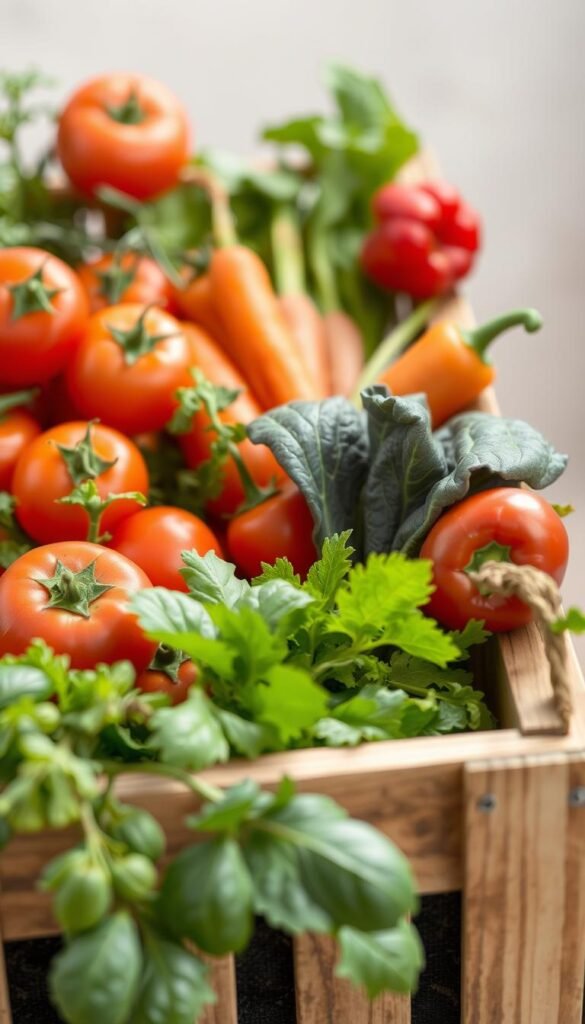
Why do some veggies thrive while others barely survive? It’s all about matching roots to real estate. Just like people need different-sized shoes, plants require containers tailored to their growth habits. A tomato’s deep roots crave 5-gallon pots, while bush beans flourish in 12-inch-deep homes.
Shallow-rooted greens like spinach adapt to 6-inch trays. But vining crops? They’ll rebel in cramped quarters. Always check your plant’s mature spread—those cute seedlings double in size faster than you’d expect. Our compact vegetables for small balconies list shows smart picks for tight spaces.
Seasonal changes matter too. Summer heat dries small pots quickly, while winter rains drown undersized containers. Swap pots as your garden evolves—a pepper might need upgrading from 3 to 5 gallons mid-season.
Here’s a golden rule: Think two steps ahead. That basil starter? It’ll triple in width. Plan for growth spurts by leaving 2 inches of soil space around young plants. Your future self will thank you when harvest time arrives!
Matching Vegetable Varieties to Their Ideal Container Sizes

Have you ever noticed how some veggies outgrow their pots while others seem stunted? The secret lies in pairing each plant with its perfect container. Let’s explore how to create custom homes for popular crops.
Tomatoes, Beans, and Herbs: Size It Right
Tomatoes need depth for their extensive roots. Indeterminate varieties thrive in 10-gallon pots—anything smaller limits fruit production. Pair with a trellis for support and ensure drainage holes prevent soggy soil.
Bush beans flourish in 12-inch-wide containers, while pole types require 18-inch depth for vertical growth. Shallow pots cause bean plants to topple when laden with pods.
Herbs like basil and oregano adapt to 8-inch containers, but rosemary demands 12 inches for its woody roots. Always consider mature spread—cramped mint becomes leggy and less flavorful.
- Tomato tip: Use 5-gallon buckets with drilled holes for patio growing
- Bean hack: Add bamboo stakes at planting to avoid root disturbance later
- Herb trick: Group moisture-loving varieties (parsley, cilantro) in self-watering pots
Shape matters as much as volume. Carrots need 14-inch-tall containers for straight roots, while lettuces prefer wide, shallow bowls. The From Seed to Spoon app provides real-time recommendations based on your garden’s conditions—track growth stages and adjust pot sizes accordingly.
Remember: One size doesn’t fit all. Match your vegetables to their ideal homes, and watch yields skyrocket!
Material Choices: Terracotta, Plastic, Ceramic, and Beyond
Your container’s material does more than just hold soil—it shapes your plant‘s future. Let’s explore how different options affect hydration, weight, and gardening success.
Weighing the Pros and Cons of Each Material
Terracotta pots breathe like cotton shirts. Their porous walls let soil dry evenly—perfect for tomatoes that hate wet feet. But they crack in freezing times and need frequent watering in summer heat.
Plastic containers stay lightweight and affordable. They’re ideal for balcony gardens where you move plants often. However, thin plastic warps under sun exposure, while thick versions last years.
| Material | Best For | Watch Out For |
|---|---|---|
| Glazed Ceramic | Peppers, herbs | Heavy weight; needs drainage holes |
| Concrete | Fruit trees | Permanent placement |
| Fabric | Root crops | Frequent watering |
Concrete planters offer stability for tall plants like indeterminate tomatoes. Their heft prevents tipping but makes repositioning impossible. Pair them with wheeled bases if you need mobility.
When choosing materials, balance looks with function. Glazed ceramic dazzles on patios but costs triple plastic. Fabric containers promote air pruning but dry out faster. Match your selection to your garden’s needs—moisture-loving varieties thrive in plastic, while drought-tolerant herbs prefer terracotta.
Pro tip: Use terracotta for Mediterranean plants like rosemary. Their breathability mimics native soil conditions, encouraging robust growth and flavorful fruit.
Managing Water, Soil, and Nutrients in Container Gardens
Why do some container gardens flourish while others wither? The answer often lies in balancing three elements: moisture, nutrients, and soil quality. Unlike traditional beds, containers create unique challenges—limited space means faster nutrient depletion and quicker drying cycles.
Mastering Moisture Control
Small pots (under 12 inches) dry out like cookies in the sun. Check them twice daily during heat waves. For larger containers, water deeply but less often—this encourages roots to grow downward. Clay pots lose moisture 25% faster than plastic, according to Miracle-Gro® trials.
| Container Size | Material | Watering Frequency |
|---|---|---|
| 6″ diameter | Terracotta | Every morning |
| 12″ depth | Plastic | Every 2 days |
| 18″ width | Fabric | Every 3 days |
Use your finger as a moisture meter. If the top inch feels dry, it’s time to water. For tomatoes, keep soil consistently damp—uneven watering causes blossom-end rot.
Mix perlite into potting soil for better drainage. Feed plants every 2-3 weeks with balanced fertilizer. Yellow leaves? That’s your garden crying for nitrogen.
Experiment with self-watering systems for busy schedules. One gardener doubled her basil yield by switching to wicking containers. Your plants will tell you what works—listen closely!
Technology and Tools to Enhance Your Container Garden
Modern gardeners are swapping guesswork for smart tech. Digital tools now simplify everything from pot selection to harvest tracking. These innovations help you grow healthier plants while saving time and resources.
Utilizing the From Seed to Spoon App for Expert Guidance
Carrie Spoonemore’s From Seed to Spoon app acts like a pocket gardening coach. Enter your container dimensions, and it suggests ideal crops—like pairing 10-gallon pots with determinate tomatoes. The app’s digital charts show spacing needs for herbs versus vining vegetables.
Users report 30% higher yields after following its watering schedules. One gardener grew bell peppers in 14-inch containers using the app’s nutrient reminders. Real-time alerts warn about overcrowding or soil imbalances before problems arise.
Leveraging Online Resources and Charts
Interactive guides take the stress out of gardening math. The University of Maryland’s virtual tool calculates container volumes based on plant root depth. Simply input your seed variety and pot material for customized advice.
| Digital Resource | Key Feature | Best For |
|---|---|---|
| Gardenize App | Progress photos + notes | Tracking plant growth |
| SmartSoil Sensor | Moisture alerts | Preventing overwatering |
| Vegetable Container Chart Pro | Size comparisons | New gardeners |
Online communities offer crowdsourced solutions. A Reddit user fixed her drooping basil by switching to self-watering pots recommended in a forum. Bookmark trusted sites like the National Gardening Association for seasonal tips.
Try syncing tools with your phone calendar. Set reminders to rotate tomatoes or refresh soil. With tech on your side, even small-space gardens can produce restaurant-worthy fruit and greens!
Final Reflections on Container Gardening Success
Your container garden‘s success starts with understanding one truth: roots drive results. Matching plants to properly sized homes prevents stunted growth and boosts yields. Remember—tomatoes demand depth, herbs thrive in cozier spaces, and leafy greens adapt to shallow trays.
Material choices matter as much as measurements. Terracotta breathes for Mediterranean plants, while plastic retains moisture for thirsty vegetables. Pair smart soil mixes with consistent watering—check moisture daily during heat waves.
Don’t set your garden on autopilot. Swap containers as plants grow, especially after germination or seasonal shifts. Tools like the vegetable container chart simplify these transitions.
Technology sharpens your skills. Apps track seed-to-fruit progress, while moisture sensors prevent overwatering. Yet nothing beats hands-on learning—each season brings new insights about your plants‘ needs.
Ready to grow? Start small with basil or cherry tomatoes. Track what works, adjust what doesn’t, and revisit resources like the From Seed to Spoon app. Your perfect container garden evolves one experiment at a time!
